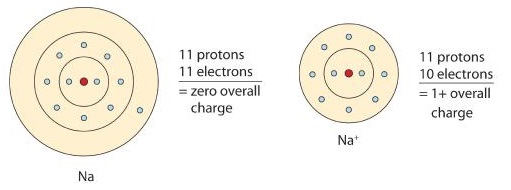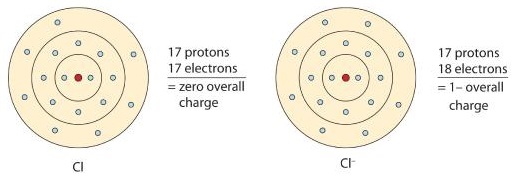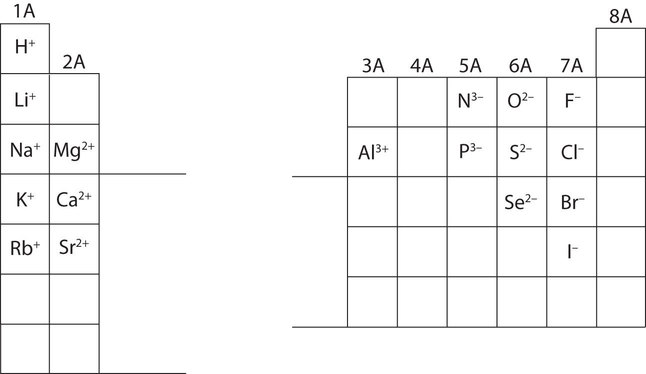1.13: Ions: Atoms That Have Lost or Gained Electrons
Learning Objectives
- Define the two types of ions.
- Predict the charge on an ion depending on its location on the periodic table.
An ion is a chemical species with an overall positive (+) or negative (-) electrical charge. In a neutral atom (one with no net charge), the number of protons is equal to the number of electrons. Ions, by contrast, do not have the same numbers of protons and electrons. Atoms that lose electrons acquire a positive charge as a result because they are left with fewer negatively charged electrons to balance the positive charges of the protons in the nucleus. Positively charged ions are called cations (“CAT-eye-ons”). Atoms that gain electrons acquire a negative charge, because they are left with more electrons than protons. These negatively charged ions are called anions (“ANN-eye-ons”).
Why would an atom either gain or lose electrons? Certain atoms can either gain or lose electrons relatively easily to attain an arrangement of electrons called an octet, which means 8 electrons. Electrons are arranged around nuclei in levels called shells, and the shell that is the furthest from the nucleus is called the valence shell. For reasons outside the scope of our present discussion, atoms generally try to attain an octet of electrons in the valence shell, thereby following what is called the octet rule. (We will revisit the details of this later in our course.) Most atoms do not have eight electrons in their valence electron shell: some atoms have only a few electrons in this outer shell, while some atoms need only one or two more electrons to have an octet. In cases where an atom has three or fewer valence electrons, the atom may lose those valence electrons quite easily until what remains is a lower shell that contains an octet.
The two examples that follow and the associated pictures show atoms either losing or gaining electrons to achieve an octet of electrons in their outermost electron shell. But don’t worry too much about octets and electron shells at this point! We will explore these ideas later in the course. Instead, for now just focus on understanding the two types of ions (cations and anions), and learn to predict the charge that will form when certain atoms become ions (in general, metals become cations and nonmetals become anions).
Cations
A neutral sodium atom is likely to achieve an octet in its outermost shell by losing its one valence electron. This equation shows a sodium atom becoming a sodium cation plus the electron that has been removed from it. We will abbreviate the electron as e–.
Na → Na+ + e–
The cation produced in this way, Na+, is called the sodium ion to distinguish it from a neutral sodium atom. The outermost shell of the sodium ion now has eight electrons in it, and the octet rule has been satisfied. Figure 1.13.1 is a graphical depiction of this process.

Anions
Some atoms have nearly eight electrons in their valence shell and can gain additional valence electrons until they have an octet. When these atoms gain electrons, they acquire a negative charge because they now possess more electrons than protons. Negatively charged ions are called anions. Most nonmetals become anions when they make ionic compounds.
A neutral chlorine atom has seven electrons in its outermost shell. Only one more electron is needed to achieve an octet in chlorine’s valence shell. (In table salt, this electron comes from the sodium atom.)
e– + Cl → Cl–
In this case, the ion has the same outermost shell as the original atom, but now that shell has eight electrons in it. Once again, the octet rule has been satisfied. The resulting anion, Cl , is called the chloride ion; note the slight change in the suffix (-ide instead of -ine) to create the name of this anion. Figure 1.13.2 is a graphical depiction of this process.

In many cases, elements that belong to the same group (vertical column) on the periodic table form ions with the same charge because they have the same number of valence electrons. Thus, the periodic table becomes a tool for remembering the charges on many ions. For example, all ions made from alkali metals, the first column on the periodic table, have a 1+ charge. Ions made from alkaline earth metals, the second group on the periodic table, have a 2+ charge. On the other side of the periodic table, the next-to-last column, the halogens, form ions having a 1− charge. Figure 1.14.3 shows how the charge on many ions can be predicted by the location of an element on the periodic table. Note the convention of first writing the number and then the sign on a ion with multiple charges. The barium cation is written Ba2+ , not Ba+2 .
Although there are some predictable patterns to the charges on elements as shown in Figure 1.13.3, many of the transition metals (not shown in the Figure) can have different charges; for example, iron (Fe) ions can have a 2+ or a 3+ charge, and copper (Cu) ions can have either a 1+ or a 2+ charge. Metals like this are said to have variable charge, meaning that they can exist as different ions with different charges. There are four exceptions to this: silver ions (Ag) always have a 1+ charge, cadmium (Cd) and zinc (Zn) ions are always 2+, and aluminum (Al) ions always have a 3+ charge. We say that these metals have fixed charge, meaning that when they are ions, they always have the same charge.

Key Takeaways
- Atoms can either lose electrons to become positively charged ions called cations, or gain electrons to become negatively charged ions called anions.
- There are some patterns we can follow to predict the type of charge many atoms will acquire when they become ions. Group 1A elements form a 1+ charge. Group 2A elements form a 2+ charge. Group 5A elements form a 3- charge. Group 6A elements form a 2- charge. Group 7A elements form a 1- charge.
- Most transition metals can form differently charged ions. The four exceptions to this (metals that always form ions of only one type of charge) are Ag (1+), Cd (2+), Zn (2+), and Al (3+).
Contributions & Attributions
- Marisa Alviar-Agnew (Sacramento City College)
- Henry Agnew (UC Davis)

